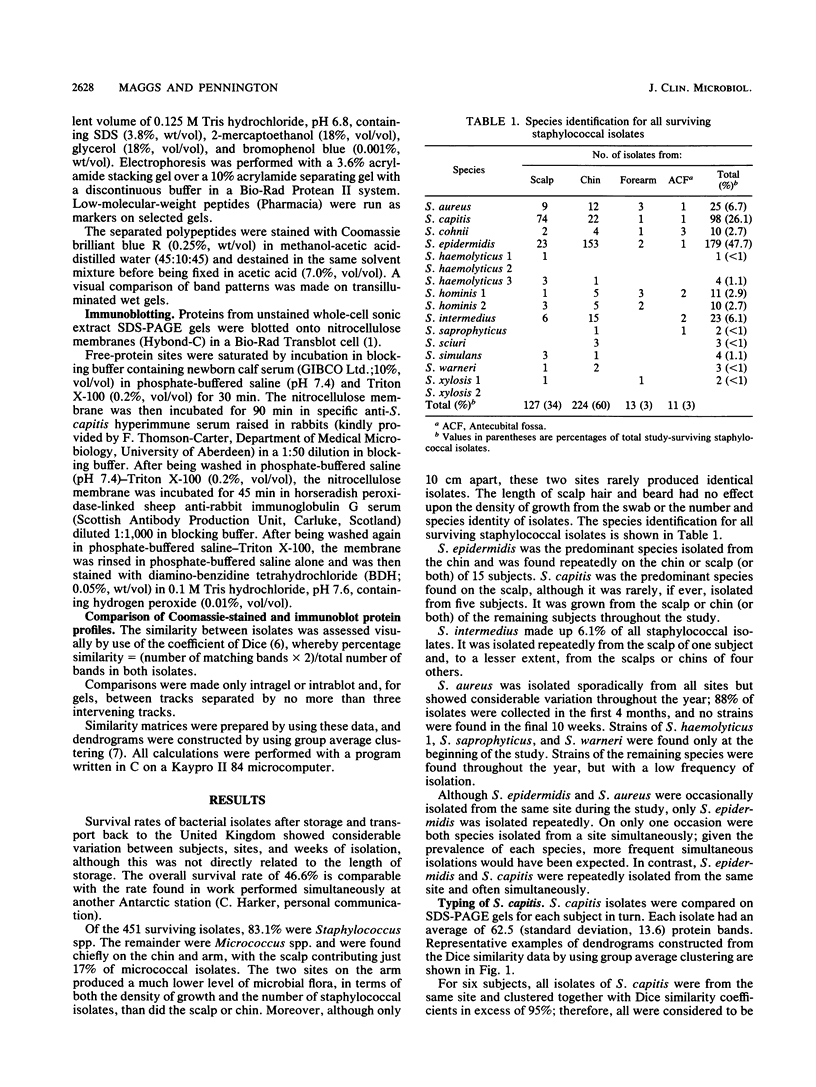Abstract
The staphylococcal skin floras of an isolated group of subjects were studied for 1 year. A wide variation in isolation patterns was found for different species. Staphylococcus intermedius, previously thought to be of veterinary origin, was found to be part of the resident flora of some subjects, and this may indicate a wider role for it in clinical infection. Sodium dodecyl sulfate-polyacrylamide gel electrophoresis (SDS-PAGE) analysis of S. capitis isolates indicated persistent skin colonization at some sites; each region was colonized by only one clone of that species, although an adjacent area could be inhabited by a separate clone. Nine clonal groups were identified by SDS-PAGE; there was a degree of specialization between the groups with regard to the sites which they colonized. The interaction between species at a single site was less well defined. Noncolonizing isolates often exhibited phenotypic similarities that were lower than expected when compared with their presumed source. The results of SDS-PAGE analysis were compared with immunoblotting, antibiograms, and biotyping, and SDS-PAGE analysis was found to be a useful and practical tool for epidemiological work.
Full text
PDF





Images in this article
Selected References
These references are in PubMed. This may not be the complete list of references from this article.
- Burnette W. N. "Western blotting": electrophoretic transfer of proteins from sodium dodecyl sulfate--polyacrylamide gels to unmodified nitrocellulose and radiographic detection with antibody and radioiodinated protein A. Anal Biochem. 1981 Apr;112(2):195–203. doi: 10.1016/0003-2697(81)90281-5. [DOI] [PubMed] [Google Scholar]
- Cameron A. S. Staphylococcal epidemiology in Antarctica. J Hyg (Lond) 1970 Mar;68(1):43–52. doi: 10.1017/s0022172400028485. [DOI] [PMC free article] [PubMed] [Google Scholar]
- Carr D. L., Kloos W. E. Temporal study of the staphylococci and micrococci of normal infant skin. Appl Environ Microbiol. 1977 Dec;34(6):673–680. doi: 10.1128/aem.34.6.673-680.1977. [DOI] [PMC free article] [PubMed] [Google Scholar]
- Cox H. U., Hoskins J. D., Newman S. S., Foil C. S., Turnwald G. H., Roy A. F. Temporal study of staphylococcal species on healthy dogs. Am J Vet Res. 1988 Jun;49(6):747–751. [PubMed] [Google Scholar]
- Deighton M. A., Franklin J. C., Spicer W. J., Balkau B. Species identification, antibiotic sensitivity and slime production of coagulase-negative staphylococci isolated from clinical specimens. Epidemiol Infect. 1988 Aug;101(1):99–113. doi: 10.1017/s0950268800029265. [DOI] [PMC free article] [PubMed] [Google Scholar]
- Gahrn-Hansen B., Heltberg O., Rosdahl V. T., Søgaard P. Evaluation of a conventional routine method for identification of clinical isolates of coagulase-negative Staphylococcus and Micrococcus species. Comparison with API-Staph and API-Staph-Ident. Acta Pathol Microbiol Immunol Scand B. 1987 Oct;95(5):283–292. doi: 10.1111/j.1699-0463.1987.tb03126.x. [DOI] [PubMed] [Google Scholar]
- Gemmell C. G., Dawson J. E. Identification of coagulase-negative staphylococci with the API staph system. J Clin Microbiol. 1982 Nov;16(5):874–877. doi: 10.1128/jcm.16.5.874-877.1982. [DOI] [PMC free article] [PubMed] [Google Scholar]
- Goodfellow M., Harwood C. R., Nahaie M. R. Impact of plasmids and genetic change on the numerical classification of staphylococci. Zentralbl Bakteriol Mikrobiol Hyg A. 1987 Aug;266(1-2):60–85. doi: 10.1016/s0176-6724(87)80021-4. [DOI] [PubMed] [Google Scholar]
- Holt R. The classification of staphylococci from colonized ventriculo-atrial shunts. J Clin Pathol. 1969 Jul;22(4):475–482. doi: 10.1136/jcp.22.4.475. [DOI] [PMC free article] [PubMed] [Google Scholar]
- Kloos W. E., Musselwhite M. S. Distribution and persistence of Staphylococcus and Micrococcus species and other aerobic bacteria on human skin. Appl Microbiol. 1975 Sep;30(3):381–385. doi: 10.1128/am.30.3.381-395.1975. [DOI] [PMC free article] [PubMed] [Google Scholar]
- Kloos W. E. Natural populations of the genus Staphylococcus. Annu Rev Microbiol. 1980;34:559–592. doi: 10.1146/annurev.mi.34.100180.003015. [DOI] [PubMed] [Google Scholar]
- LOWRY O. H., ROSEBROUGH N. J., FARR A. L., RANDALL R. J. Protein measurement with the Folin phenol reagent. J Biol Chem. 1951 Nov;193(1):265–275. [PubMed] [Google Scholar]
- Laemmli U. K. Cleavage of structural proteins during the assembly of the head of bacteriophage T4. Nature. 1970 Aug 15;227(5259):680–685. doi: 10.1038/227680a0. [DOI] [PubMed] [Google Scholar]
- Lyon B. R., Skurray R. Antimicrobial resistance of Staphylococcus aureus: genetic basis. Microbiol Rev. 1987 Mar;51(1):88–134. doi: 10.1128/mr.51.1.88-134.1987. [DOI] [PMC free article] [PubMed] [Google Scholar]
- Marples R. R., Richardson J. F. Evaluation of a micromethod gallery (API Staph) for the identification of staphylococci and micrococci. J Clin Pathol. 1982 Jun;35(6):650–656. doi: 10.1136/jcp.35.6.650. [DOI] [PMC free article] [PubMed] [Google Scholar]
- Marsik F. J., Brake S. Species identification and susceptibility to 17 antibiotics of coagulase-negative staphylococci isolated from clinical specimens. J Clin Microbiol. 1982 Apr;15(4):640–645. doi: 10.1128/jcm.15.4.640-645.1982. [DOI] [PMC free article] [PubMed] [Google Scholar]
- NOBLE W. C., WILLIAMS R. E., JEVONS M. P., SHOOTER R. A. SOME ASPECTS OF NASAL CARRIAGE OF STAPHYLOCOCCI. J Clin Pathol. 1964 Jan;17:79–83. doi: 10.1136/jcp.17.1.79. [DOI] [PMC free article] [PubMed] [Google Scholar]
- Noble W. C. Skin carriage of the Micrococcaceae. J Clin Pathol. 1969 May;22(3):249–253. doi: 10.1136/jcp.22.3.249. [DOI] [PMC free article] [PubMed] [Google Scholar]
- Parisi J. T. Coagulase-negative staphylococci and the epidemiological typing of Staphylococcus epidermidis. Microbiol Rev. 1985 Jun;49(2):126–139. doi: 10.1128/mr.49.2.126-139.1985. [DOI] [PMC free article] [PubMed] [Google Scholar]
- Rae P. F., Thrusfield M. V., Higgins A., Aitken C. G., Jones T. W., Luckins A. G. Evaluation of enzyme immunoassays in the diagnosis of camel (Camelus dromedarius) trypanosomiasis: a preliminary investigation. Epidemiol Infect. 1989 Apr;102(2):297–307. doi: 10.1017/s0950268800029976. [DOI] [PMC free article] [PubMed] [Google Scholar]
- Richardson J. F., Marples R. R. Changing resistance to antimicrobial drugs, and resistance typing in clinically significant strains of Staphylococcus epidermidis. J Med Microbiol. 1982 Nov;15(4):475–484. doi: 10.1099/00222615-15-4-475. [DOI] [PubMed] [Google Scholar]
- Sewell C. M., Clarridge J. E., Young E. J., Guthrie R. K. Clinical significance of coagulase-negative staphylococci. J Clin Microbiol. 1982 Aug;16(2):236–239. doi: 10.1128/jcm.16.2.236-239.1982. [DOI] [PMC free article] [PubMed] [Google Scholar]
- Talan D. A., Staatz D., Staatz A., Goldstein E. J., Singer K., Overturf G. D. Staphylococcus intermedius in canine gingiva and canine-inflicted human wound infections: laboratory characterization of a newly recognized zoonotic pathogen. J Clin Microbiol. 1989 Jan;27(1):78–81. doi: 10.1128/jcm.27.1.78-81.1989. [DOI] [PMC free article] [PubMed] [Google Scholar]
- Wallmark G., Arremark I., Telander B. Staphylococcus saprophyticus: a frequent cause of acute urinary tract infection among female outpatients. J Infect Dis. 1978 Dec;138(6):791–797. doi: 10.1093/infdis/138.6.791. [DOI] [PubMed] [Google Scholar]



